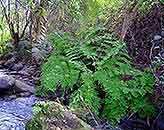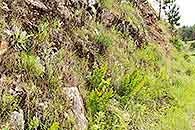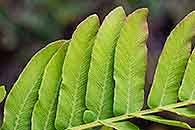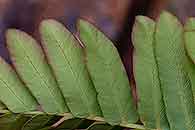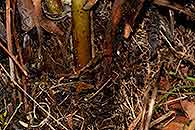Osmunda regalis L.
Synonyms |
Osmunda capensis C.Presl |
|---|---|
Common name |
Royal fern |
Description |
Rhizome erect to suberect, up to 30 cm tall, often becoming massive, covered with the persistent winged bases of the stipes, usually embedded in a mass of black fibrous roots. Fronds tufted, erect, with a rufous tomentum when young, glabrous at maturity, 60-200 × 30-45 cm. Stipe up to 30 cm long, pale green when fresh and straw coloured when dry, glabrous at maturity. Lamina up to 1 m, bipinnate and ovate in outline. Sterile pinnules oblong-lanceolate in outline, apex rounded, base asymmetrically truncate to broadly wedge-shaped, ± 8 x 2 cm, hairless on both surfaces at maturity, margin minutely serrate. Fertile pinnules reduced in size, ± 3 x 0.3 cm, borne in the apical portion situated on the end of the lamina and covered with sporangia. |
Notes | Easy to recognize by its large size and characteristic fertile portion. |
Derivation | regalis: regal, royal; referring to the majestic growth of the plant or to King Osmund (Osmunda) of the South Saxons. |
Habitat | Along streams in woodland and forest with the rhizome continuously in water, swamps with Cyperaceae. |
Distribution worldwide | Africa, temperate parts of Europe, Asia, America, Madagascar, Mascarene Islands. |
Distribution in Africa |
Algeria, Angola, Benin, Burkina Fasso, Burundi, Cameroon, Central African Republic, Congo, Dem. Republic of Congo, Equatorial Guinea (incl. Bioko), Ethiopia, Guinea, Kenya, Lesotho, Liberia, Malawi, Mali, Morocco and Western Sahara, Mozambique, Nigeria, Rwanda, Sudan and South Sudan, Swaziland, Tanzania , Tunesia, Zambia, Zimbabwe. |
Growth form |
Lithophytic, terrestrial. |
Literature |
|
